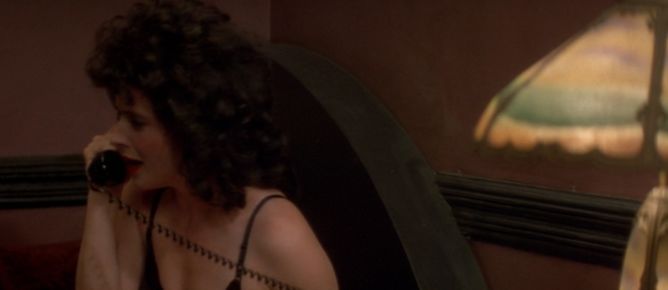 Back to selection
Back to selection
The Blue Velvet Project
Blue Velvet, 47 seconds at a time by Nicholas Rombes
The Blue Velvet Project, #46

Second #2162, 36:02
“Frank? Frank! What’s the matter with him?” Dorothy pleads on the phone about her kidnapped husband and son, Don and “little Donny.” There are facts, and there are facts of the frame:
1. This shot of Dorothy completely breaks with Jeffrey’s implied point-of view from the closet.
2. Dorothy is a woman in trouble.
3. This is the first instance of Frank in the film, invisible over the phone line, somewhere else, an implied presence and absence at the same time.
4. Dorothy’s maternal vulnerability, the fact of it, and the way that Jeffrey will sense and exploit this.
5. If this were a science-fiction film, the alarm that Dorothy sounds in this phone exchange would result in the calling in of forces that, even if not on the side of good, would have at least come to some sort of annihilating rescue.
In his book Theory of Film (1960), Siegfried Kracauer (the great film theorist whom Pauline Kael mocked) wrote that
[what] accounts for the cinematic quality of films, however, is not so much their truth to our experience of reality or even to reality in a general sense as their absorption in camera-reality—visible physical existence.
And that’s it: the total absorption of Dorothy into Blue Velvet’s camera-reality, a reality so intense and textured at this moment that it erases the conditions of its own existence: it just is. At times like this, Blue Velvet demands such an intense loyalty to the details of the moment–who is at the other end of the phone? why does Dorothy call him “sir”?–that the fact that what we are watching is just a film is beside the point. We are really in it now. What’s inside the film is as real as what’s outside.
* The Blue Velvet Project will continue with post #47 on Monday, November 28.
Over the period of one full year — three days per week — The Blue Velvet Project will seize a frame every 47 seconds of David Lynch’s classic to explore. These posts will run until second 7,200 in August 2012. For a complete archive of the project, click here. And here is the introduction to the project.
